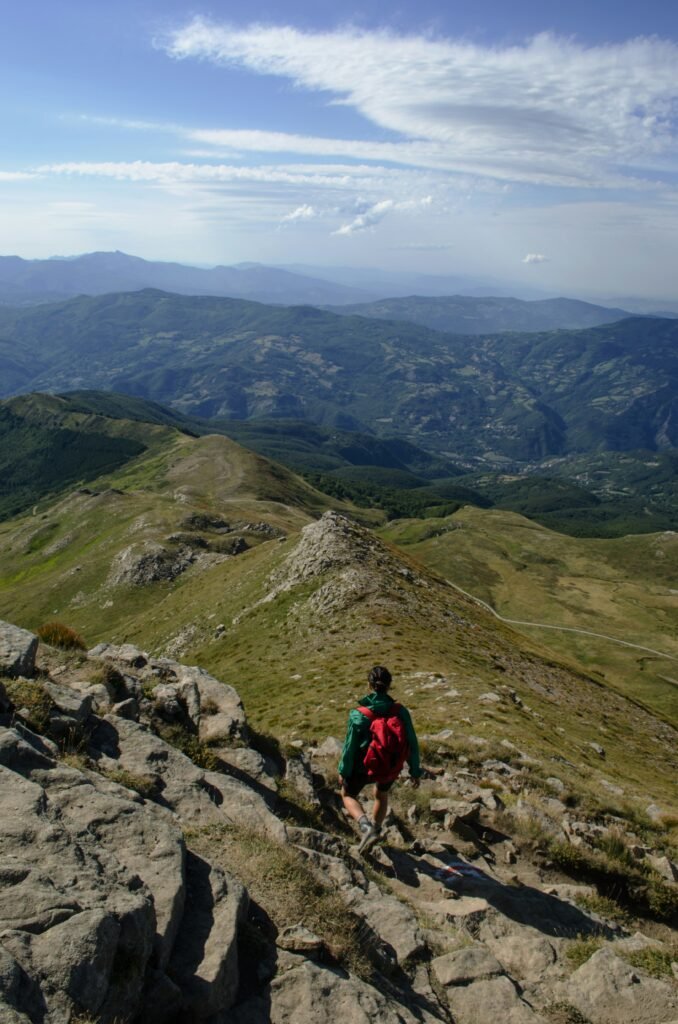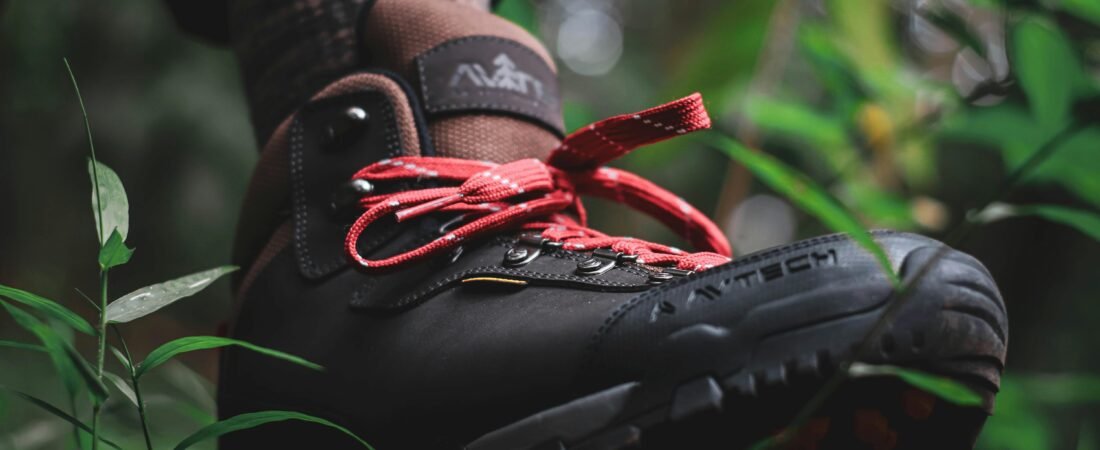Last updated: July 2025
Not many annoying things can compete with blisters on your feet when hiking. Which is why I decided to save you the trouble and make write this guide to clarify the difference between different kinds of shoes for hiking.
Planning your first day hike or prepping for a multi-day backpacking trip? This comprehensive guide will help you choose between hiking boots, trail runners, and hiking shoes. I’ll share real-world testing insights, specific product recommendations, and the exact decision framework I use to match footwear to terrain. Let’s dig in.
Table of Contents
*This post may contain affiliate links. If you use them, I may earn a small commission at no extra cost to you.
Why Your Hiking Footwear Choice Matters
Your feet are your primary mode of transport on the trail. Poor footwear choices lead to:
- Painful blisters and hotspots
- Rolled ankles and foot injuries
- Premature fatigue from heavy, ill-fitting shoes
- Cut-short adventures due to foot pain
The right hiking footwear, however, becomes an extension of your body—comfortable, supportive, and simply something that you can forget about as you focus on the trail ahead.
After personally testing many pairs of hiking footwear across diverse terrains—from the rocky peaks to the muddy trails —I’ve identified three distinct categories that serve different hiking needs.
The 3 Main Types of Hiking Footwear
Quick Comparison Chart
| Feature | Hiking Boots | Trail Runners | Hiking Shoes |
|---|---|---|---|
| Weight | Heavy (2-4 lbs) | Light (1-2 lbs) | Medium (1.5-3 lbs) |
| Ankle Support | High | Minimal | Moderate |
| Durability | Excellent | Good | Very Good |
| Breathability | Low | High | Medium |
| Break-in Time | Long | Minimal | Short |
| Best For | Technical terrain, heavy loads | Fast hiking, day trips | Versatile all-around use |
Hiking Boots: Maximum Support and Durability
When to Choose Hiking Boots
Hiking boots are your go-to choice when you need maximum support and protection. They excel in:
- Technical, rocky terrain with loose rocks
- Multi-day backpacking with heavy loads (30+ lbs)
- Wet, muddy, or snowy conditions
- Off-trail hiking and scrambling
- Situations requiring maximum ankle support
Pros of Hiking Boots
- Superior ankle support prevents rolls and twists on uneven terrain
- Exceptional durability – quality boots last 1,000+ miles
- Weather protection with waterproof options available
- Excellent traction on challenging surfaces
- Protective against rocks, roots, and debris
Cons of Hiking Boots
- Heavy weight increases leg fatigue over long distances
- Extended break-in period required to prevent blisters
- Less breathable leading to sweaty feet in warm weather
- Expensive with quality options starting around $150+
- Overkill for easy, well-maintained trails
Real-World Testing Experience
I wore heavy leather boots on my first 3-day backpacking trip in the Cascades. While they provided excellent support on the rocky, root-filled trails, by day two I was questioning my choice as my legs felt like lead. However, when we hit a section with loose scree and stream crossings, I was grateful for the protection and stability they provided.
Top Hiking Boot Recommendations
Best Overall: Salomon Quest 4D 3 GTX
- Excellent ankle support without being overly stiff
- Proven durability across 500+ miles of testing
- Waterproof Gore-Tex construction
- Price range: $200-250
Best Value: Merrell Moab 3 Mid Waterproof
- Comfortable out-of-the-box fit
- Reliable waterproofing
- Good traction on varied terrain
- Price range: $130-160
Best for Technical Terrain: La Sportiva Nucleo High GTX
- Aggressive traction for scrambling
- Precise fit for technical moves
- Excellent build quality
- Price range: $180-220
Trail Running Shoes: Lightweight Performance
When to Choose Trail Runners
Trail runners are perfect for hikers who prioritize speed, comfort, and minimal weight. They’re ideal for:
- Well-maintained trails with minimal technical challenges
- Day hiking with light loads
- Fast-paced hiking or trail running
- Warm weather conditions
- Ultralight backpacking
Pros of Trail Runners
- Minimal weight reduces fatigue on long hikes
- Excellent breathability keeps feet cool and dry
- Quick-drying materials handle stream crossings well
- Comfortable immediately with minimal break-in required
- Versatile for both hiking and everyday wear
Cons of Trail Runners
- Limited ankle support increases injury risk on technical terrain
- Shorter lifespan typically 300-500 miles
- Less protection from rocks and debris
- Poor performance in wet or cold conditions
- Not suitable for heavy loads
Real-World Testing Experience
Switching to trail runners transformed my day hiking experience. On a 15-mile day hike in the Sierra Nevada, my feet felt fresh at the end, and I barely noticed the weight difference. However, on a recent hike with loose rock sections, I definitely missed the ankle support and protection of boots.
Top Trail Runner Recommendations
Best Overall: Salomon Speedcross 5
- Aggressive traction for varied terrain
- Comfortable, secure fit
- Excellent durability for trail runners
- Price range: $110-140
Best for Rocky Terrain: Hoka One One Speedgoat 6
- Maximum cushioning for comfort
- Excellent protection from rocks
- Stable platform despite thick midsole
- Price range: $140-160
Best Budget Option: Merrell Trail Glove 6
- Minimalist design for natural foot movement
- Excellent ground feel
- Durable construction
- Price range: $90-110
Hiking Shoes: The Versatile Middle Ground
When to Choose Hiking Shoes
Hiking shoes offer the best balance of support, comfort, and versatility. They’re perfect for:
- Mixed terrain with moderate technical challenges
- Day hiking to light overnight trips
- Hikers who want one shoe for various trail types
- Moderate to heavy day pack loads
- Variable weather conditions
Pros of Hiking Shoes
- Balanced weight – lighter than boots, more supportive than runners
- Versatile performance across different terrain types
- Moderate ankle support without restriction
- Good durability lasting 500-800 miles
- Comfortable with minimal break-in
Cons of Hiking Shoes
- Jack-of-all-trades but master of none
- Less specialized than boots or runners for specific conditions
- Moderate protection may not be enough for very technical terrain
- Limited options compared to boots and runners
Real-World Testing Experience
Hiking shoes have become my go-to choice for 90% of my hiking. My current pair of mid-cut hiking shoes has carried me through over 400 miles of diverse terrain, from desert trails to mountain paths, with consistent comfort and performance.
Top Hiking Shoe Recommendations
Best Overall: Salomon X Ultra 4 Mid GTX
- Excellent all-around performance
- Comfortable Gore-Tex waterproofing
- Proven durability
- Price range: $150-180
Best Value: Keen Targhee III Mid WP
- Roomy toe box for comfort
- Reliable waterproofing
- Good traction
- Price range: $120-140
Best for Wide Feet: Merrell Moab 3 Mid
- Accommodating fit
- Comfortable cushioning
- Available in multiple widths
- Price range: $110-130
How to Choose the Best Hiking Footwear for You
Step 1: Assess Your Hiking Style
Ask yourself:
- What types of trails do you typically hike?
- How often do you hike?
- Do you prefer day hikes or multi-day trips?
- What’s your typical pack weight?
Step 2: Consider Your Terrain
Rocky, Technical Trails
- Choose: Hiking boots or sturdy hiking shoes
- Why: You need ankle support and protection from rocks
Well-Maintained, Smooth Trails
- Choose: Trail runners or hiking shoes
- Why: Comfort and breathability matter more than protection
Mixed Terrain
- Choose: Hiking shoes
- Why: Versatility for changing conditions
Step 3: Factor in Weather and Conditions
Wet, Cold, or Snowy Conditions
- Choose: Waterproof boots or Gore-Tex hiking shoes
- Why: Dry feet are essential for comfort and safety
Hot, Dry Conditions
- Choose: Breathable trail runners or non-waterproof hiking shoes
- Why: Breathability prevents overheating

Step 4: Consider Your Pack Weight
Light Day Pack (Under 20 lbs)
- Choose: Trail runners or hiking shoes
- Why: Less weight on your feet = less fatigue
Heavy Pack (Over 30 lbs)
- Choose: Hiking boots
- Why: You need maximum support for the added weight
Step 5: Know Your Foot Type
High Arches
- Look for: Cushioned midsoles and arch support
- Avoid: Minimalist or very firm shoes
Flat Feet
- Look for: Motion control and stability features
- Avoid: Highly cushioned or curved shoes
Wide Feet
- Look for: Brands known for wider fits (Keen, Merrell)
- Avoid: Narrow European brands
Waterproof vs Breathable: What You Need to Know
The Waterproof Dilemma
Waterproof shoes keep water out, but they also trap moisture in. This creates a tradeoff between external protection and internal breathability.
When to Choose Waterproof
- Frequent hiking in wet conditions
- Stream crossings are common
- Cold weather hiking
- Multi-day trips where dry feet are crucial
When to Choose Breathable
- Hot, dry climates
- Well-draining trails
- Day hikes where you can dry out afterwards
- High-intensity hiking where breathability matters
My Recommendation
For most hikers, I recommend having both options: waterproof shoes for wet conditions and breathable shoes for dry conditions. However, if you can only choose one, go with waterproof for versatility.
Breaking In Your New Hiking Footwear
The Right Way to Break In Hiking Shoes
Week 1: Indoor Wear
- Wear for 1-2 hours daily around the house
- Focus on identifying pressure points
- Use thick hiking socks
Week 2: Short Walks
- Take 30-60 minute walks on varied surfaces
- Gradually increase distance
- Monitor for hot spots
Week 3: Mini Hikes
- Try 2-3 mile hikes on easy terrain
- Carry a light pack
- Bring blister prevention supplies
Week 4: Full Testing
- Take a challenging day hike
- Test in conditions you’ll actually use them
- Make final adjustments
Blister Prevention Tips
- Use moisture-wicking hiking socks
- Apply blister prevention tape to known problem areas
- Ensure proper fit (thumb’s width in toe box)
- Don’t ignore hot spots – address them immediately
Final Recommendations
For Beginners
Start with hiking shoes – they offer the best balance of comfort, support, and versatility while you discover your hiking preferences.
For Day Hikers
Trail runners if you stick to well-maintained trails, hiking shoes if you explore varied terrain.
For Backpackers
Hiking boots for traditional backpacking with heavy loads, trail runners for ultralight approaches.
For Technical Hikers
Hiking boots with aggressive tread and maximum support.
The One-Shoe Solution
If you can only have one pair, choose mid-cut hiking shoes with Gore-Tex. They handle 80% of hiking conditions well.
Key Takeaways
- Match your footwear to your terrain and hiking style – don’t just follow trends
- Proper fit is more important than brand – try before you buy
- Break in new shoes gradually – never test new footwear on important hikes
- Consider having multiple pairs for different conditions
- Invest in quality hiking socks – they’re as important as the shoes
Remember, the best hiking footwear is the pair that fits your feet, matches your hiking style, and keeps you comfortable on the trail. Take time to try different options, and don’t rush the decision. Your feet will thank you for the extra effort.
This guide is based on extensive field testing and personal experience. Individual results may vary based on foot shape, hiking style, and terrain preferences. Always try footwear before purchasing and consider consulting with outdoor gear specialists for personalized recommendations.
Related Reading:

Leave a Reply